Search This Blog
Popular Posts
-
Hello there! My blog post 'Spikes' was published on Sept. 22nd; however, the post before it called 'Flow' was published on...
-
Are you looking for the best WordPress themes for nonprofits? Charity and non-profit websites require appealing presentation with tools to...
-
The best Black Friday / Cyber Monday WordPress Deals in 2016 all in one place. If you missed the huge deals last year, be sure to get in...
-
Chris Hinds, COO of Road Warrior Creative, once worked up to 89 hours per week in the food industry. However, he found the lifestyle t...
-
CHECK OUR LATEST STYLISH WORDPRESS BLOG THEME UPDATE OF THE THEME Theme is WordPress 3.5 Ready! We just updated font setting...
-
Hot Off the Press Two New Blogging U. Courses Available On Demand Jun 20, 2016 @ 7:18 pm Michelle W. Jun 20, 201...
-
Google has some big plans when it comes to making the web faster on your mobile phone. The company just added AMP-enabled pages in its mobil...
-
How to Get WordPress Hosting WordPress, the world's top content management system (CMS), is far more than just the simple blogging pl...
-
Hi there, I see you are a Jetpack user. I checked your site on Jetpack Debug page (https://jetpack.com/support/debug/) for connection is...
-
One of the cool features of Azure is the ability to have a "deployment slot" for your web app. Web app content and configurations...
Blog Archive
- December (18)
- November (29)
- October (27)
- September (29)
- August (31)
- July (30)
- June (29)
- May (29)
- April (30)
- March (31)
- February (28)
- January (31)
- December (31)
- November (30)
- October (31)
- September (30)
- August (43)
- July (42)
- June (33)
- May (43)
- April (36)
- March (37)
- February (31)
- January (4)
- December (1)
- November (1)
- October (24)
- September (24)
- August (25)
- July (28)
- June (18)
- September (1)
Total Pageviews
Blogroll
My blog gets suspend
As you are referring to sites that you have had suspended/archived blog read: Suspended Blogs and Siteshttps://en.support.wordpress.com/suspended-blogs/
We cannot assist with any blog suspension issues in these support forums. Contact the Terms of Service Staff please. You were provided with a link to do that https://en.support.wordpress.com/suspended-blogs/ in the warning. Please use it.
You may wish to read these:http://wordpress.com/types-of-blogs/http://en.support.wordpress.com/advertising/http://en.wordpress.com/tos/
Mistakes can be made but we Volunteers are asked not to discuss or to encourage any discussion of these private matters on the public support forums. Our role is to direct to the relevant support doc https://en.support.wordpress.com/suspended-blogs/, and request that Support Staff close the thread, as only Terms of Service Staff have authority in these cases.
Source: My blog gets suspend
liking another's blog post
Your login information, ability to click like buttons and to comment applies only to sites hosted by WordPress.COM and not to any other sites.
That site is hosted here so that points to a browser issue. Please act on all the tips here https://en.support.wordpress.com/browser-issues/ first.
• Make sure you are running an up to date browser version found at http://browsehappy.com• Make sure you have both JavaScript and third party cookies enabled https://en.support.wordpress.com/third-party-cookies/#how-do-i-enable-third-party-cookies.• Disable any adblocker browser add-ons and all browser extensions and adons.• Try clearing your browser cache https://en.support.wordpress.com/browser-issues/#clearing-your-browser-cache• Try using another browser.
If you are not successful please post this specific info here:(a) Exactly what kind of device you are using to connect to the internet and to WordPress.com.(b) Exactly which browser (and version of it) you're using by checking here if necessary http://supportdetails.com/
Then type modlook into the sidebar tags on this thread for a Staff follow-up. How do I get a Moderator/Staff reply for my question? https://en.support.wordpress.com/getting-help-in-the-forums/#how-do-i-get-a-moderatorstaff-reply-for-my-question Also subscribe to this thread so you are notified when they respond and be patient while waiting. To subscribe look in the sidebar of this thread, find the subscribe to topics link and click it.
Source: liking another's blog post
How to Grow Your WordPress Business with Virtual Assistants
As a freelancer/entrepreneur, there's a definite limit to how many things you can do in a day.
Of course, being involved in the industry of web development means that you may have planned out your day to work on one project, only to have to deal with an emergency a client suddenly makes you aware of and that demands a quick fix.
You really can't blame clients for taking this attitude with you, as the websites you create for them serve an important business purpose. If these online properties are down or broken in some way, it reflects badly on the client and, ultimately, on you (even if the client is the one who broke the website!).
At any rate, in order to grow, and in some case to maintain your sanity you'll eventually get to the point in your business where you just can't be completely effective on your own.Whether you want to make more money, or just need some backup to provide excellent service (or both), you'll want to consider the implications of growing your WordPress business by building a virtual team.
Whether you want to make more money, or just need some backup to provide excellent service (or both), you'll want to consider the implications of growing your WordPress business by building a virtual team.
The perfect place to start is by hiring a virtual assistant.
What is a Virtual Assistant?Help can be known by many different titles in your freelance business. You might opt to hire a full-time employee if you're growing fast, but most people start with a part-time employee or contractor as they scale up. The distinction between a contractor and an employee is a fine line, but legitimately claiming someone as a contractor can save you big time in payroll taxes and other associated costs.
A virtual assistant is one type of contractor that many online businesses turn to during their initial growth phase. The name "virtual assistant" does a good job of describing what they do – helping you to execute tasks while they working remotely.
You can hire a virtual assistant to work with you for a number of different tasks. Most people start their virtual team with a virtual assistant who focuses on research projects to help their business and general administrative functions.
That said, you can also hire more specialized VAs who have experience with specific business activities like social media, graphic design, and of course—WordPress development.
If you're lucky, you'll find someone who knows a little bit of everything to start who can be coached through whatever they don't know with regards to common tasks you deal with in your WordPress business.
As you grow, you'll benefit from growing your team with more specialized members to execute different business functions.
How Outsourcing Tasks Helps You Spend Time on More Important WorkThe point bears repeating: you only have so much time in a day to accomplish things.
Some freelancers wear double-digit hour workdays and working on weekends as a badge of honor, but that sort of bodily stress is hardly sustainable, and definitely not enviable.
The fact of the matter is that there are definitely some things you don't personally need to be doing.
Think of it this way – not every task in your business is directly revenue generating. You should start making a list of these things as potential tasks to hand off.
Outsource tasks such as these to someone else, so you can focus on what only you can do.
If you're really good at/enjoy sales, outsourcing major business tasks is a great way to build your business if you can provide proper training to your team, and maintain high-quality output to customers.
How to Build Your Virtual TeamOnce you've recognized the need to grow your WordPress business with a virtual team, the next questions you'll inevitably have revolve around where to recruit contractors and how much you should expect to pay for help.
First, a look at where to recruit team members:
Some of the most affordable virtual assistants come from countries like India or the Philippines. Individuals from these countries work off of very low hourly rates.
Some people think it's unethical to take advantage of their willingness to do so, especially as it lowers the payment bar for freelancers worldwide. Others justify hiring virtual assistants at low rates from these countries because they have a very low cost of living compared to many across the globe.
When it comes to hiring help for your business, budget is an important consideration, but it's just as important to realize that there's a point where you can't scale your business without spending money on your team.
The trick to being effective is to sell more projects and retainers at a rate high enough to satisfactorily support the members of your team without taking away from your ability to make decent money.
Onlinejobs.ph offers the following guidance for setting full-time rates to add virtual assistants to your team, based on specific service offerings and specialties:
The thing is, just because you think you can get away with paying the bare minimum, it likely won't spark a sense of loyalty in your virtual assistant. It's better to pay a few dollars above the minimum rate per hour so that you can build a team that lasts.
Less contractor turnover results in smoother sailing for your WordPress business.
It's also important to realize that most virtual assistants are looking for full-time work, or part-time work with the potential for full-time work as they help you to increase efficiencies in your business. Of course, in order to bring on a virtual assistant full-time, you'll need to create an ongoing list of tasks to outsource and learn how to effectively delegate without creating more work for yourself.
Tasks to Outsource to a Virtual AssistantThe specific tasks you outsource will depend heavily on the nature of your business. You might want to start brainstorming before you get to the hiring stage so that you can give virtual assistant hopefuls a taste of what it would be like to work with you. Think of tasks in terms of:
When it comes to WordPress specific tasks, your virtual assistant can help you in a number of ways, even if they're not highly proficient in the platform.
Consider delegating WordPress-related tasks like:
Besides working directly within your business, consider the implications of hiring team members to help with sales (as affiliates if it doesn't make sense to hire someone outright), marketing, and even for business tasks like bookkeeping and accounting.
Figuring out what tasks to outsource is just as much about the skill of your virtual assistant as it is about how much you trust them. If you've just hired a new virtual team member, get them started with basic behind the scenes work before assigning them any client-facing tasks.
When client-facing roles become necessary, create a branded company email address for them to respond from to keep things consistent and less confusing for your clients.
Basics of Delegating to a Virtual AssistantIf you've ever held a role as a manager, the art of delegation will likely be familiar and comfortable to you. But if you're a freelancer who's never been a position to tell others what to do, it can be a little uncomfortable.
At any rate, here are some basic considerations to delegate tasks like a pro:
Create additional efficiencies and revenue opportunities in your business by hiring help. Start small with a general virtual assistant, and expand your team over time to include more specialized roles.
Through trial and error, you'll learn how to delegate tasks without creating extra work for yourself.
Source: How to Grow Your WordPress Business with Virtual Assistants
Best Responsive Conference & Event WordPress Themes
Launching your own conference website on WordPress is the easiest way to go. You have so many great themes to pick from and there's a design for practically every topic from tech conferences to creative meetups and everything inbetween.
If you're in charge of designing a conference website then I highly recommend these fully responsive WP themes.
They're all incredibly detailed and come out of the box with all the features you'll need. Plus these themes make it easy for event organizers to log in and make changes on their own without any tech background.
Sungit Lite

The Sungit Lite theme is a great place to start if you want something free and easy to use. It features the typical hero header along with a strong responsive navigation that runs on any mobile device.
You can use this theme for other events like concerts or meetups too. But it works especially well for conferences where you want to list out the scheduled speakers, ticket prices, hotel/flight accommodations, and other related information.
It's not one of the fanciest themes but since you can get the lite version for free it's worth looking into.
Although there is a paid version if you want extra styles and default features. But you can get by with the lite version just fine and launch a kick-ass conference site without any worry.
Fudge Lite

The Fudge Lite theme is another example of a free WordPress layout made specifically for conferences.
Naturally it is fully responsive and designed for all browser resolutions. The navigation menu folds up nicely and it even supports dropdown links if you need them. Although I find this theme to work better in a minimalist style.
If your conference site only has a few pages then this is the best theme you could start with. Since it's free you'll need to do some customizing to get it looking like the demo preview.
But with the right photos and all the proper event information you should have a beautiful website up in no time.
Conference Pro

To dive right into the higher end of WP's theme library check out Conference Pro.
This is no doubt one of the best conference/event themes you can get. It comes from the Showthemes library which is full of these kinds of WP themes. They're also one of the best WP theme makers out there and since they specialize in event-style designs they know their way around WordPress APIs.
With the Conference Pro theme you get a complete frontend GUI editor which lets clients & event organizers edit the site. This way they can change dates, pricing, scheduled speakers, and whatever else needs updating over time.
Plus this theme connects naturally into sales platforms like Eventbrite, Tickera, or WooCommerce. This way you can easily sell tickets however you want and connect sales links right into the theme.
I'll cover a few more of their themes in this list but you can also compare their features using this table. It's surprisingly accurate and one of the easiest ways to figure out what's best for you.
In my eyes Conference Pro is the best for a physical conference with speakers, scheduled events, and international attendees.
Mondree

One more event-style theme you might like is Mondree. Again this comes from Showthemes and this one's a bit cheaper than the others.
Yet it still comes with a lot of the same(or similar) features like an improved page editor, social media integration, and countdown timers for ticket releases or event dates.
One big reason I like this theme is the detailed event management. You'll find this in most Showthemes designs and it's one of the best reasons to go with their styles.
In the WP backend you can manage who's speaking, who's attending those talks, and how much space you have for workshops. Typically this info would be handled externally but now you can save it via WordPress too.
The theme itself is only $79 but you can get longer support & setup for an extra fee.
Januas

Running a conference with many different events at the same time? Then check out Januas which is the first theme of its kind to support this feature in WordPress.
You can use this for two equally valuable setups:
Larger events like SmashingConf are a good example of events that run multiple times per year.
With this theme you get the same features as other Showtheme designs, but with the added bonus of managing multiple events in one place. A great choice for conferences managed by one company or worldwide confs that run in different locations.
Eventum

Out of all the colorful and wacky event themes out there none compare to Eventum.
This is a full conference management theme that gives you control over the content for speakers, events, workshops, and timelines for tickets(including early bird pricing).
You can setup the homepage with a countdown ticker and a CTA button to get visitors further engaged with the site. I also like the fixed navbar that scrolls along with the visitor.
It features a bright orange "buy" button that's sure to grab attention. This theme is practically optimized for sales so it's not just great for usability, but also for marketing.
Take a peek at the demo on ThemeForest and see what you think. It's basically a perfect solution for any conference regardless of subject matter and it's super easy to customize.
Infinite

I'm not always a fan of WP themes that come with dozens of different layouts. But with Infinite the design is actually quite good and the responsive techniques work flawlessly.
Just note this theme is not inherently a conference theme. It's just a regular WordPress theme which has a conference demo layout included with 20+ other theme styles.
This certainly doesn't make it bad and you should look into the demo page to see what you think.
But I'd mostly recommend this for anyone who could use the license for demoing other themes. It's not just a conference design, although the conference style is pretty solid.
Grand Conference

Now here's a WP theme that comes with many variations where they all focus on conference layouts.
I had trouble finding a theme like this but I knew there'd be at least one. Grand Conference is a fantastic choice if you go with ThemeForest and the design comes with dozens of custom layouts.
You can select from fullpage hero headers, smaller header photos, grid layouts, opt-in field headers, and plenty of other demo designs.
This way you're not just buying a single theme. You're buying a theme with dozens of custom layouts each tailored to a different event. Some work better for music festivals, others work better for corporate conferences.
But either way this event theme is the tops and should be on your list of viable options to pick up.
Ventcamp

The Ventcamp theme is a much simpler design and this one only comes with 4 demos. But what it lacks in variety it makes up for with a customizable page editor.
On the backend you can edit every page with a live visual editor. This means you can drag & drop elements or change text right from the page itself. Pretty cool!
This also comes with support for a bunch of other cool features:
The live customizer is real easy to use and it's one of the best you'll find at this price. Granted there are better WP editor plugins but they don't always work with custom themes.
Check out Ventcamp and see what you think. If the customizer feels like a fit then definitely grab a copy of this theme.
Eventr

Looking for a simple one-page theme? Then look no further cause Eventr has everything you need for a great single page conference website.
The default hero header image is gorgeous but you can easily change this with photos from your event. It uses custom Google fonts for unique typography and the navigation is super clean.
It stays fixed while you scroll which makes this even easier to navigate, especially on mobile. But since it's a single page design you only need one navigation tier(no dropdowns) because there aren't any internal pages.
But the nav links use pretty scrolling so when you click a link it animates down to that page section rather than doing quick jumps.
Not to mention it comes with all the features you'd need for a conference: speakers, daily schedules, pricing info, venue info, hotel recommendations, conference testimonials and even a photo gallery. All fully responsive too!
MiEvent

Another single-page design you might like is the MiEvent theme. This isn't perfect and I don't particularly like the forced scrolling animation change.
But it does feature many other great animations like on-scroll visibility for event features and icons. This adds some elegance to the theme and you don't need to do anything to get these animations working.
Some people may find this annoying because it requires scrolling to actually view the page. Others may love it since this breathes life into the layout.
Nothing wrong with either opinion but I will say that MiEvent is not for everyone.
Check out the live demo and see what you think. If it meshes with your goals then definitely consider grabbing a copy.
Evnt

With the Evnt theme you can choose to run a single page design or run it with multiple pages(including dropdown navigation).
This makes it far more versatile than other choices and it still features a lot of the same design accents. Large hero headers, countdown timers, and tabbed scheduling are all included among many other default features.
And once you install this theme it comes with a one-click demo install that autopopulates pages for you. This is an excellent way to launch a conference site fast and test how the theme should look with content.
From there you can go through and delete pages, change content, and restyle the demo to suit your needs.
Great for anyone who wants to launch their own conference website but doesn't know how to edit WordPress themes.
Eventim

If you want something a little more unique then Eventim is worth checking out.
It's definitely not the "norm" for conference pages but it's a gorgeous theme with two main styles: one for business events and another for larger conferences.
These demos include many variations where you can style single-page layouts or repurpose the homepage to focus more on the speakers, workshops, event signup dates, or all three.
Eventim uses a lot of animated effects so if you're not big on that you probably won't like the theme. But it is really clean and naturally responsive so it should work fine on any mobile device.
But regarding "extra" features I can't say Eventim is the best choice.
I mostly recommend this for WP users who know their way around a theme. This makes an excellent base for customizing the layout and adding/removing features to get the perfect design.
PlanUp

PlanUp is another fairly unique theme for conference & event websites. It uses a gorgeous header style with a unique navigation hover effect to boot.
Take a peek at the single page demo to get an idea. Again this hijacks user scrolling which I really don't like, but if you know how to edit CSS/JS then you can easily remove this.
What I like most is the default style for every component on the page. From the photo slideshow to the venue registration everything just feels natural and blends perfectly into the design.
It's one of the best event themes with a funky layout that really does work well.
The event scheduling feature even lets you add a vertical timeline design so you can show workshops and scheduling in real time. Definitely not a theme for everyone but if you like the style and the component behaviors then give this a shot.
Either way this post should have something for everyone so take another look and make note of your favorite themes. Once you find a design that fits your conference it's super easy to get it online, user-focused, and maintained for years to come.
Source: Best Responsive Conference & Event WordPress Themes
WordPress SEO Plugins Compared: Yoast SEO and All IN One SEO
WordPress is rather SEO friendly on its own; however, by using an SEO plugin, you would be able to take website optimization to an entirely new level. Plugins offer you more capabilities and options and let you take control over how your content is going to appear in the SERPs and on the social media networks. These plugins also help you produce great content which has high chances of ranking well in the search engine results.
The most comprehensive SEO plugins available in the WordPress repository are the 'All in One SEO Pack' and Yoast SEO'. The All in One SEO Pack came out in 2007 and has been one of the most downloaded WordPress plugins. Launched in the year 2010, the Yoast SEO plugin has seen a lot of improvements and now offers a huge range of amazing features.
If you have a WordPress website or are setting up one, we understand your dilemma when it comes to choosing between these two. Both of them are excellent plugins and offer all of the features that you need to get the maximum benefits, complementing your great content strategy. This detailed blog post is here to simplify your doubts about the supremacy of one over the other.
Content OptimizationContent optimization is undoubtedly one of the most important parts of SEO. Let us see which one performs better here.
Yoast SEO – The Yoast SEO has a meta box of its own towards the bottom of the WP Editor. This helps in controlling how your content is going to appear in the SERP's. With this, you also get the chance to create a snippet with the link as well as Meta description and title of your own. It also has a content analysis feature which analyses your content for the best SEO practices.
All in One SEO Pack – This plugin enables you to edit the title and meta description and also has an option that allows disabling indexing, setting up canonical URL's and much more. You would also get the chance to attach your own pictures and descriptions for the purpose of sharing on social media sites if you activate the social media Add-on. However, this plugin doesn't have the content analysis tool.
Verdict – Both of these plugins work on excellently to help you edit how your site appears in the search engine results. But, the All in One SEO doesn't have the content analysis tool and that makes the Yoast SEO a bit better.
Ease of Installation and SetupThe All in One SEO Pack and Yoast SEO can easily be found in the WordPress.org Plugin Repository. However, it does take up a lot of practice and training so as to understand and implement the SEO concepts into a website. Here, we will see as to how easy it is to setup and configure the plugin for a WordPress site owner who may or may not be a newbie.
All in One SEO Pack – Once you have installed and activated the plugin, you would be able to find the menu item right below the dashboard. Most of the configurations are similar to that of Yoast which means that the settings are quite extensive. However, unlike Yoast, they are all clubbed in together on the same page with separate tabs. This makes it a bit more confusing for the beginner to find things.
Yoast SEO – After installing and activating the plugin, you would see an option that gives you a tour of the different settings that are available. The setting section of this plugin is divided neatly into pages wherein each of the pages has different tabs for each of the settings. This makes it easier for the user to understand and setup this plugin on their site.
Verdict - Undoubtedly both of the plugins has a lot of options, and both of them try their best to simplify things for a user. All in One SEO Pack would be great for a beginner. However, Yoast SEO seems to remain unbeatable for the advanced SEO users with their tabbed settings and multi-pages.
XML SitemapsThe sitemaps are a tool which is used for getting your content indexed appropriately. They essentially provide a map of your site which tells the search engine as to how to index it and provide this information to the search engines.
Yoast SEO – Yoast SEO has its own menu, especially for the XML sitemaps. They are basically a default option and are created automatically and also get updated whenever new content is introduced. You can have a look at the sitemaps in the settings section and decide the kind of post that you want to include.
All in One SEO Pack – This plugin doesn't really have XML sitemaps as a default feature, and you would require activating it from the Feature Manager. This would create a Sitemap automatically and provide you with an extra configuration menu. With this, you can set decide the parts of the content you want to be included, set which search engines are to be notified and do several other things.
Verdict - As is evident, both of these plugins offer the feature of XML sitemap however they handle it differently. Yoast SEO has a default feature while the All in One SEO Pack has a lot of other options and features on offer.
Other FeaturesOn Page SEO is a rather comprehensive process and therefore, both of these plugins offer so many additional features and tools rather than just the meta tags. All these features provide an all-in-one solution and thereby eliminate the need to install several plugins.
Yoast SEOThis plugin has been loved by so many people. With this plugin, other than the above-mentioned ones, you get a lot more features and extensions like multiple focus keywords; redirect manager, open graph Meta tags, export/import SEO data, breadcrumb navigation, social previews, built-in robots.txt and .htaccess editor.
All in One SEO PackThis plugin undoubtedly does come with a lot of features. However, not all of them are activated by default. You would need to activate them at the Features Manager in order to activate them. A few of its features are file editor, performance manager, advanced WooCommerce support, advanced Google analytics support, import and export SEO data, robots.txt, bad bot blocker and SEO for custom taxonomies.
ConclusionBoth of these plugins offer quite a similar set of features and tools. Also, both of these plugins have their own set of benefits and disadvantages. It is entirely up to you to decide which one you are going to use. You can take all of the above things into account and decide which one is the best plugin for you. Do let us know which one is your favorite SEO plugin by dropping a comment below.
This has been a guest blog post by Kiera Hayes. All opinions represented in this post are entirely the author's and not indicative of the opinions or suggestions of RocketTheme or the RocketTheme team. Kiera Hayes is a passionate Blogger and Web Developer. She enjoys reading and writing articles whenever she gets time from her work.
Join the ConversationPlease enable JavaScript to view the comments powered by Disqus.
comments powered bySource: WordPress SEO Plugins Compared: Yoast SEO and All IN One SEO
Should You Disable Comments on Your WordPress Blog?
It's exciting when readers of your blog take the time to leave comments on your posts. It's often what makes the arduous process of creating content feel totally worth it at the end of the day.
Of course, you could always see how many people visited your posts in Google Analytics, but there is something especially rewarding about seeing them engage with it right on the page by leaving a comment.
Then again, there are times when those comments just aren't welcome.
Clearly, there are a number of reasons why you might want to disable comments on your WordPress blog. But since you aren't the first person to make that decision, let's see what the research says about disabling comments and check out some examples of bloggers and news sites who have blazed the trail before you.
Disabling Comments: What the Research SaysFor some of you, comment threads will be a welcome addition to your website. Look at the WPMU DEV blog as an example. The comment sections are a great place to engage with the writers, the developers at WPMU DEV, as well as your peers in the web development community. Comments tend to be helpful and insightful and really add value to the experience of reading content found here.
For some websites, leaving active comment boards like this open will make sense. For others, it won't and that's fine. If you need help turning off WordPress comments or need to delete/archive old ones, check out how to do this here.
Before you do that, however, I'd urge you to take a look at the following research and real-life cases that demonstrate the pros and cons of disabling blog comments.
Neil Patel's FindingsIn research conducted by Neil Patel, he found little proof that comments make a significant contribution to SEO. He did say, however, that 16% of his own site's search traffic comes from keywords found in his blog comment threads. Of course, Patel typically receives hundreds of comments on each post, so his observation likely isn't applicable to the average business blog.
ShoutMeLoud's FindingsHarsh Agrawal argued the opposite. He believed that relevant and high-quality comments play a significant role in your post's search ranking. He inadvertently demonstrated this point when he set out to improve his site's commenting system.
What he did was remove the standard commenting feed on his site—effectively deleting all of the comments that had been there before—and replaced it with the Google+ comment system. As a result, there was a 40% drop in search traffic over the course of two days. He concluded then that comments (plus the keywords and page length they add to a post) do actually contribute to SEO.
Fizzle's Comment DebateFizzle interviewed two popular bloggers to find out why one chose to disable comments and one opted to keep them put.
Everett Bogue's blog, Far Beyond the Stars, has about 70,000 visitors every month. He turned off commenting as a sort of "test". After observing the results of his test, he decided to leave comments off for good. Here is why:
Pat Flynn's blog, The Smart Passive Income Blog, has roughly 80,000 visitors each month. Each post of his receives at least 50 comments. He argued to keep comments because:
Piggybacking on top of what Everett Bogue noted about his readership, NPR found a similar breakdown of readers-versus-commenters on their blog.
In the end, NPR decided to ditch the commenting system which often ran far over budget (they had to pay more as the number of comments grew). Since it was clear only a small portion of readers were leaving comments, they decided to close down commenting and direct readers to the much cheaper-to-manage social media platforms.
What Happened to Websites that Disabled Comments?There have been a number of notable blogs that disabled comments in the past. Some ultimately backtracked on that decision and turned them back on. There are others who remain comment-less and seem perfectly content with that decision. And then there are a few who are somewhere in between, with a commenting system in place but more stricter moderation to keep tabs on what readers are allowed to place on the site.
Here are some examples:
CopybloggerBack in 2014, Copyblogger announced that they were going to remove comments from their blog. They did it for a number of reasons, though it seems that the primary issue was how much time it took them to manage and respond to them.
In 2016, they changed course and decided to bring comments back. They believed that receiving direct feedback on the site and having those conversations with readers was important. However, in order to get around the issue of time spent managing comments, they put a seven-day limit on how long each board would remain open.
Michael HyattVirtual mentor Michael Hyatt yanked comments from his site years ago. The primary motivation behind this move was to do away with the Disqus commenting tool which had suddenly started to monetize the platform. He believed this made for an intrusive experience with readers and he wanted to be done with it. He also believed that social media was a better battleground for comments to take place on.
After discovering a drop in traffic in 2015, Michael Hyatt decided that commenting had played a role in the performance drop. As a result, he brought comments back. He noted a number of reasons for this move, including a desire to encourage dialogue, to create a sense of community, and to centralize all his readers' comments in one place.
Gawker MediaA few years back, Gawker Media's stable of web properties was facing an onslaught of graphic content uploads within their comment feeds. The temporary solution to fix the issue was not to remove the commenting system. Instead, they decided to disable all image and video content uploads within comments.
Once they had the problem under control, they put a long-term fix in place: a pending commenting system. They believed that by doing this, they could safely continue to have media-rich conversations with readers and ensure that the experience would not be tainted by trolls who wanted to upload harmful content.
Chicago TribuneThe Chicago Tribune is another online publication that decided not to do away with commenting when faced with trolls who tried to use their website as a place to spew hate speech and try to stir [email protected]#$ up. Here is the official reason they gave:
"They say a hostile atmosphere not only keeps them from commenting, but it can keep them from spending time reading our stories. We believe a commenting platform for our subscribers—our most loyal and presumably most frequent readers—will create a well-lit environment for robust discussions on the news and issues of the day."
Many people were unhappy with the Tribune's choice to only allow comments from paying subscribers; however, the decision allowed the newspaper to keep community discussion flowing without having to subject them to irrelevant and harmful discourse.
Blog Marketing AcademyDavid Risley, the man behind Blog Marketing Academy, disabled comments in 2016 and has yet to reverse that decision. In his experience, blog comments:
So, instead, he chose to carry out discussions with his audience as they related to his blog content on social media. He's built a private community on Facebook which is especially active in engaging with him in fruitful discussions.
News WebsitesIn general, online news blogs are the ones who have really had to grapple with this idea of whether comments are worth keeping around. All of the issues mentioned above entered heavily into this debate and are what ultimately drove publications like Reuters, The Week, and Popular Science to shut down their commenting systems entirely.
Wrapping UpPerhaps you have the time to monitor and respond to every comment that comes through. Maybe you already have things under control by using a pending commenting system that keeps trolls at bay. And maybe you find that there is a lot of value—for your readers as well as for your site's SEO—to keep comments around.
As always, the decision to disable comments on your WordPress blog is something you'll need to make on your own. No two websites are alike, so what worked for Neil Patel or for Popular Science might not work for your blog. This is about assessing the real value of including or excluding comments on your blog and then developing a solution that's right for you.
Source: Should You Disable Comments on Your WordPress Blog?
Access to my blog
Are you referring to this site https://theshanmarielife.wordpress.com/?
It seems it was registered by https://en.forums.wordpress.com/profile/theshanmarielife
You have to be logged in as Admin http://en.support.wordpress.com/user-roles/#administrator under the exact same username account that registered the blog to access the blog's dashboard. The Admin login link to the dashboard for every blog hosted by wordpress.COM is:
http://NAME_OF_BLOG.wordpress.com/wp-admin/
* You will have to replace "name_of_blog" with the actual blog's name in that URL.
I recommend bookmarking that link or memorizing it.
You can update your email address here https://wordpress.com/me at any time.
If you are not logged in under the correct username account then clear your browser cache https://en.support.wordpress.com/browser-issues/#clearing-your-browser-cache and cookies https://en.support.wordpress.com/browser-issues/#clearing-wordpress-com-cookies and then login correctly under the relevant username account.
If you did not register the site under your username account and do not have the required access, then you need to contact the person who registered the account and site under it, and have them act or transfer the site to your username account by using this process. http://en.support.wordpress.com/moving-a-blog/#transferring-your-blog-to-another-user-or-account
If the login information has been lost go tohttps://en.support.wordpress.com/passwords/https://en.support.wordpress.com/passwords/#lost-password
If you check each and every possible email address and account and are not successful gaining access to the blog(s) then you must complete the form for account recovery at this link https://en.wordpress.com/wp-login.php?action=recovery and submit it to the Account Recovery Staff, and provide proof ownership, so they can contact you by email ie. not on these public support forums, which are available to everyone with internet access.
Support Staff cannot breach the privacy policy and provide the log-in information. You have to provide proof ownership to Account Recovery Staff to gain access https://en.support.wordpress.com/account-recovery/
Source: Access to my blog
Can't seem to show: Blog, Portfolio, Static Page, Team, Social, and Front Page Widget Area?
Need help? Check out our Support site, then
WordPress.com Forums » Support
Can't seem to show: Blog, Portfolio, Static Page, Team, Social, and Front Page Widget Area?
amieeallenMemberSep 23, 2017, 9:13 PM
Got all the correct boxes ticked, but the above sections will not show. Can you help me with this please? https://antibodiesandunclebodies.wordpress.com/
The blog I need help with is antibodiesandunclebodies.wordpress.com.
You must log in to post.
About this TopicSource: Can't seem to show: Blog, Portfolio, Static Page, Team, Social, and Front Page Widget Area?
How to Create a Video Gallery in WordPress (Step by Step)
Recently, a user asked us how to create a video gallery in WordPress. WordPress makes it easy to embed videos in your blog posts, but it does not allow you to create video galleries out of the box. In this article, we will show you how to easily create a video gallery in WordPress.

WordPress makes it easy to embed videos in your blog posts by simply entering the video URLs. It can also display hosted videos on your own website.
However, you should never upload videos to WordPress. Videos are large files and serving them directly may cause issues with your WordPress hosting service.
You can easily add a single video into your posts but what if you wanted to show multiple videos on a page?
One way to do this is by adding one video after another. While it works, it creates an unpleasant user experience because it requires a lot of scrolling.
Wouldn't it be nicer if you could create a video gallery with thumbnails just like a photo gallery? This would allow you to show more videos in less space by utilizing a beautiful mobile friendly grid.
Let's take a look at how to easily create a video gallery in WordPress.
Method 1: Create a Video Gallery in WordPress with Envira GalleryFor this method, we'll be using the Envira Gallery plugin. It is the best WordPress gallery plugin in the market. It also has a videos addon which allows you to create beautiful mobile-responsive video galleries in WordPress.
Envira Gallery is a paid plugin, and you'll need at least their pro plan to access the videos addon.
WPBeginner users can use this Envira Gallery coupon to get 25% off.
First thing you need to do is install and activate the Envira Gallery plugin. For more details, see our step by step guide on how to install a WordPress plugin.
Upon activation, you need to visit Envira Gallery » Settings page to add your license key. You can find this information from your account on Envira Gallery website.
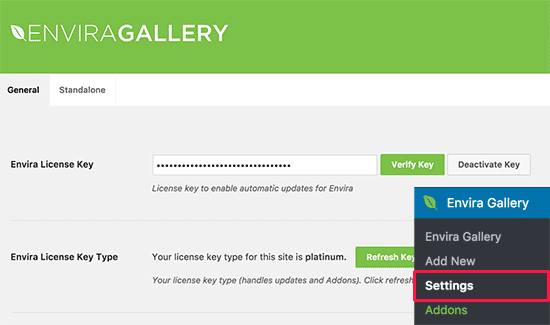
Next, you need to head over to the Envira Gallery » Addons page. You'll see all the addons available for you to install. Look for the Videos addon and install it.
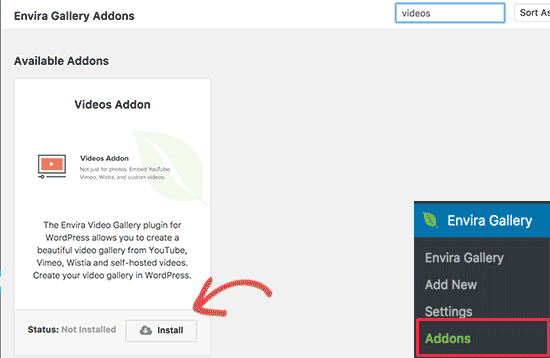
Envira Gallery will now fetch and install the videos addon. After that, you need to click 'Activate' to start using it on your website.
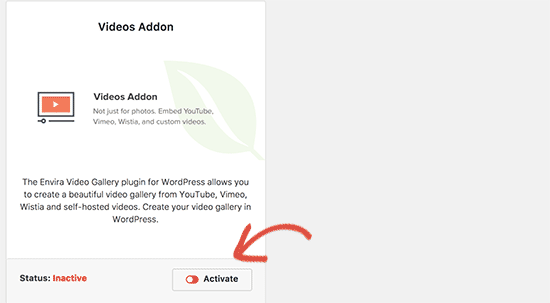
Now you are ready to create your first video gallery.
Head over to the Envira Gallery » Add New page to create your gallery. First, you need to provide a title for your gallery.
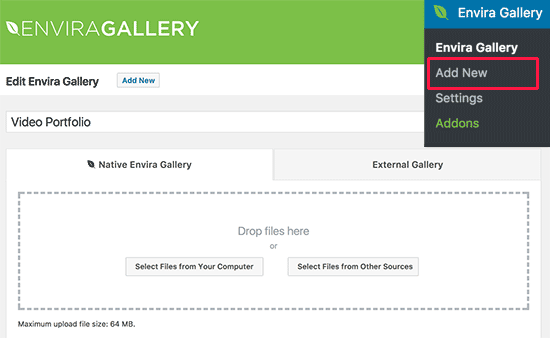
Envira Gallery can create a video gallery of self-hosted videos as well as videos hosted on YouTube, Vimeo, and Wistia. We recommend using third-party video hosting services for better user experience.
First, you'll need to upload your videos to YouTube or Vimeo. After that, click on 'Select videos from other sources' button to continue.
This will bring up the Insert Media popup where you need to click on the 'Insert videos' link in the left column.
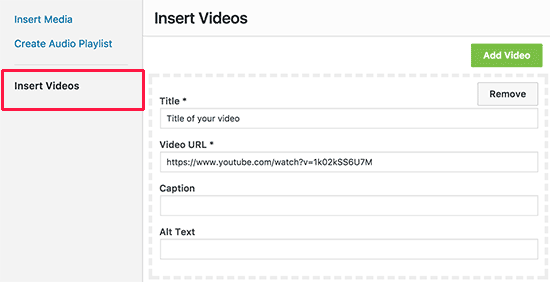
You need to click on the 'Add Video' button to enter the title and the video URL.
To add more videos, click on the 'Add Video' button again. Feel free to add as many videos as you need.
Once you have added all the videos you want to show in the gallery, click on the 'Insert into Gallery' button to continue.
Envira will now fetch the thumbnails for your videos and show them under the images section.
You can edit videos at any time by clicking on the 'pencil' icon or remove any video. You can also add more videos if needed.
Your video gallery is almost ready. Let's configure the video gallery settings.
Start by clicking on the 'Config' tab in the left column, and under 'Number of Gallery Columns' options select two or three column layout.
This ensures that your video thumbnails appear nicely with adequate space between each video.
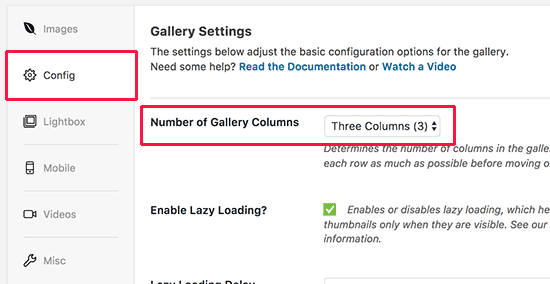
Now let's add the play button to your video thumbnails.
Switch to the 'Videos' tab and check the box next to 'Display play icon over gallery image' option.
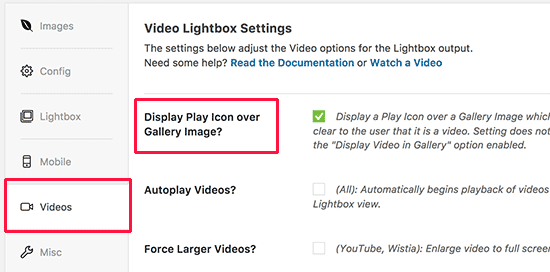
Your video gallery is now ready. Go ahead and click on the publish button to make your video gallery available to WordPress.
Display Video Gallery on Your Website
Envira Gallery makes it easy to display your video gallery in any WordPress post or page. You can also display the gallery in a sidebar.
Let's create a new page in WordPress and give it an appropriate title, for example: 'Videos'.
Next, click on the 'Add Gallery' button on top of the post editor.
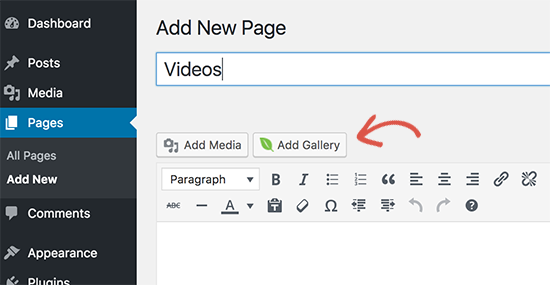
This will bring up a popup where you'll see your video gallery. Click to select it and then click on the Insert button.
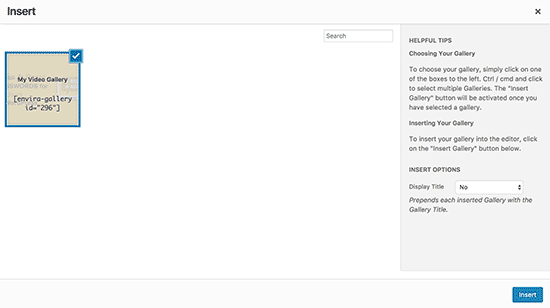
Envira Gallery shortcode will now appear in your post editor.
You can now update or publish your page and visit the page to see your video gallery in action.

The best part is that clicking on a video item will open it in a lightbox popup with theater mode. This offers a far better viewing experience for your users.
They will be able to view the video without leaving your website, and they can also browse other videos in the gallery by clicking on the thumbnails below the player.

This method requires a YouTube API key to work, which makes the process a bit lengthier. Don't worry we'll walk you through it.
First thing you need to do is install and activate the YouTube Channel Gallery plugin. For more details, see our step by step guide on how to install a WordPress plugin.
Next, you need to head over to Google Developer Console website to generate a YouTube API key.
Click on the 'Select a project' button at the top left corner of the screen and then click on the add button.
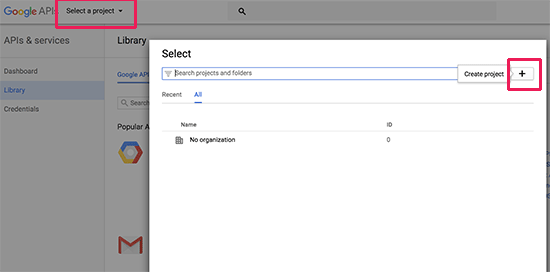
On the next screen, you need to provide a name for your project and agree to the terms of service. After that click on the create button to continue.
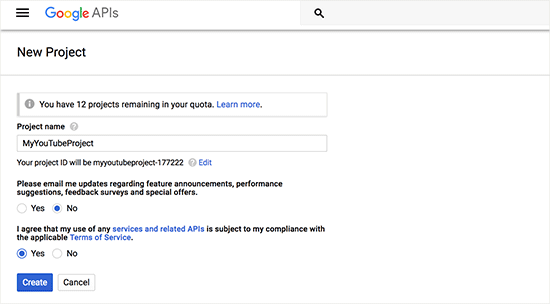
Next, you need to click on the API Library and then select YouTube Data API link.

This will bring you to the API details page where you need to click on the Enable link to turn on this API for your project.
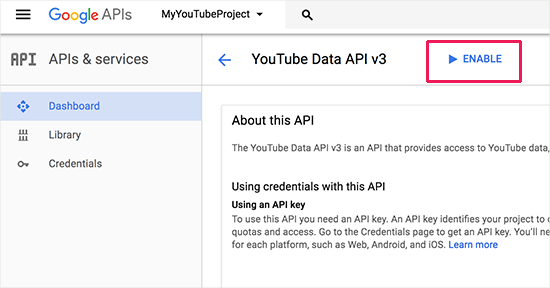
Developer console will now enable the API for your project. You still need to create credentials to get to the API key.
Click on the 'Create credentials' button to continue.
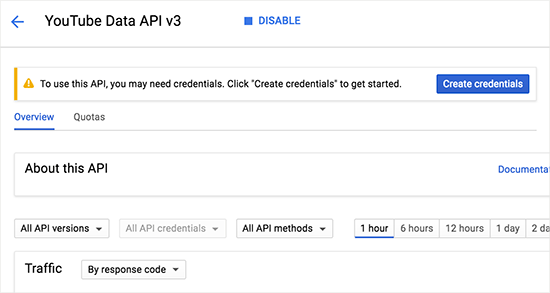
Now you need to enter how you will be using the API key. For 'Where will you be calling the API from?' option select 'Web browser (JavaScript)' and select 'Public Data' under 'What data will you be accessing?' option.
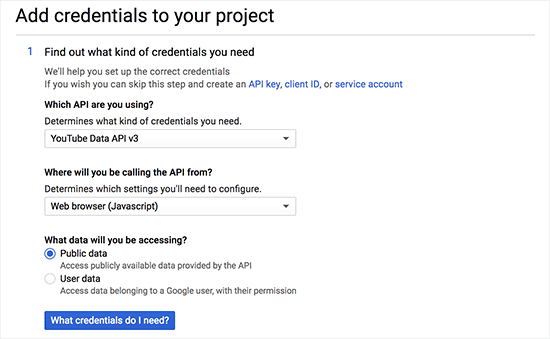
Click on 'What credentials do I need' button to continue.
Developer console will now show your API key. You need to copy and paste this API key in a plain text file. You'll need it later to create video galleries.
There is one last step remaining which is to restrict your API key to be used only on your website. To do that, click on the Restrict key link shown on your API key screen.
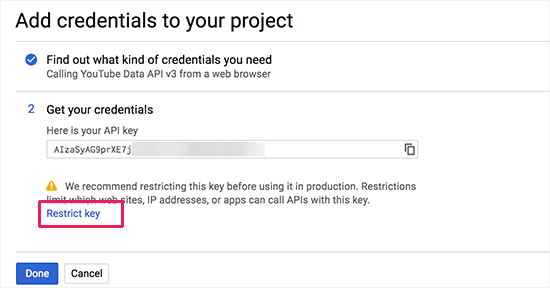
On the restrictions page, select HTTP Referrers option and then enter your domain name below in the following format:
*.yourdomain.com
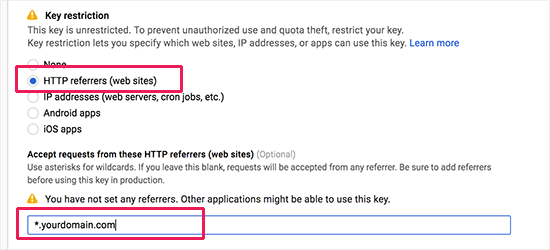
Don't forget to click on the save button to store your changes,
Now that you have got your YouTube data API key, it's time to create your video gallery.
YouTube Channel Gallery plugin comes with a powerful shortcode that you can add to your posts and pages to display your video gallery.
Simply create a new page or edit an existing one, and add the following shortcode inside the post editor.
[Youtube_Channel_Gallery user="wpbeginner" maxitems="8" thumb_columns_phones="2" thumb_columns_tablets="4" key="your-youtube-api-key-goes-here"]
Don't forget to replace the user with your YouTube username, and the key with the YouTube API key you created earlier.
You can now save your post/page and visit your website to see your video gallery in action.

The plugin does not have lightbox popup, and your videos will be played on the page. Clicking on a video thumbnail in the gallery will play the video in the top player.
For more details, please see our tutorial on how to show latest videos from your YouTube channel in WordPress.
That's all for now.
We hope this article helped you learn how to easily create a video gallery in WordPress. You may also want to see our ultimate step by step guide on how to boost WordPress speed and performance.
If you liked this article, then please subscribe to our YouTube Channel for WordPress video tutorials. You can also find us on Twitter and Facebook.
Source: How to Create a Video Gallery in WordPress (Step by Step)